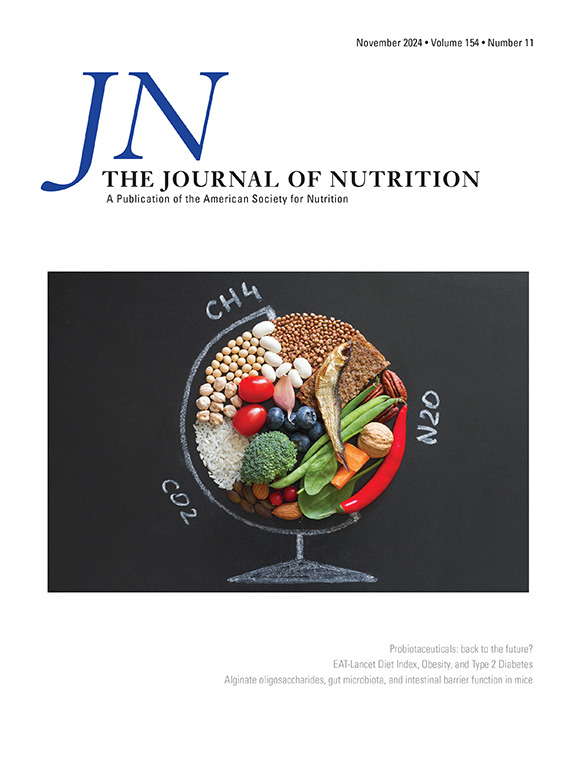Calcium and Phosphorus Retention and Excretion in Different Strains of Laying Hens during Brooding Period and Key Genes Regulating Calcium and Phosphate Transport
IF 3.7
3区 医学
Q2 NUTRITION & DIETETICS
引用次数: 0
Abstract
Background
Calcium (Ca) and phosphorus (P) intake during brooding affects laying hens’ later production and health, with availability varying among strains, necessitating further investigation of the factors influencing these differences.
Objectives
This study aimed to compare the availability of Ca and P and related gene expression among 3 high-yielding layer strains during the first 6 wk and identify genes strongly associated with nutrient absorption.
Methods
Ninety pullets (1-d-old, female) from 3 strains [medium size, large egg layer (ML), light size, medium egg layer (LM), and dwarf, small egg layer (DS) weighted 31.533 ± 0.63 g, 39.367 ± 1.40 g, and 34.099 ± 0.64 g, respectively] were randomly assigned to 6 replicates of 15 birds each for 6-wk cage rearing. Feces were collected weekly to track the Ca and P availability. Initial and final body weights and tibial lengths were recorded to determine growth performance. Intestinal samples were collected to determine the gene expression of Ca and P transporters [transient receptor potential cation channel subfamily V member 6, calbindin D28k, Na+/Ca2+ exchanger 1 (NCX1), plasma membrane Ca-ATPase 1b, and sodium-dependent phosphate transporter IIb (NPt2b)] as well as tight junction proteins (claudin-2 and claudin-12).
Results
ML and LM pullets exhibited significantly greater body weight (443 g, 436 g compared with 319 g, P < 0.001) and tibial length (70.6 mm, 69.6 mm compared with 59.2 mm, P < 0.001) than DS. Notably, during the sixth week, the Ca and P retention in DS (0.847 g/wk compared with 1.648 g/wk, 0.662 g/wk compared with 1.141 g/wk) was significantly lower than that in ML, and in most weeks, DS exhibited the lowest Ca availability among the 3 strains. Gene expression analysis revealed higher expression levels of Ca transporters in the duodenum of ML and LM than in DS, whereas DS demonstrated elevated transporter expression in the jejunum. Furthermore, ML and LM exhibited more pronounced expression of tight junction proteins across most intestinal segments.
Conclusions
The study indicated that expression of Ca and P transporter is highest in the duodenum, and duodenal NCX1, NPt2b were the genes most significantly positively correlated with the retention and excretion of Ca and P in pullets.
研究说明:不同品系蛋鸡育雏期钙、磷的滞留排泄及钙、磷转运调控关键基因的研究。
背景:育雏期钙磷摄取量影响蛋鸡后期的生产和健康,且不同品系的钙磷摄取量不同,有必要进一步研究影响这些差异的因素。目的:本研究旨在比较3个高产蛋鸡品系前6周钙、磷的有效性及相关基因的表达,找出与养分吸收密切相关的基因。方法:选取ML、LM和DS 3个品种(体重分别为31.533±0.63g、39.367±1.40g和34.099±0.64g) 90只1 d龄雌雏,随机分为6个重复,每个重复15只,笼养6周。每周收集粪便以追踪钙和磷的有效性。记录初始和最终体重和胫骨长度以确定生长性能。收集肠道样本,检测Ca和P转运蛋白(TRPV6、CaBP-D28k、NCX1、PMCA1b、NPt2b)以及紧密连接蛋白(CLDN-2、CLDN-12)的基因表达。结果:大鼠体质量(443g, 436g vs 319g, P < 0.001)和胫骨长度(70.6mm, 69.6mm vs 59.2mm, P < 0.001)均明显大于大鼠。值得注意的是,在第6周,DS的钙和磷保留量(0.847g/周vs 1.648g/周,0.662g/周vs 1.141g/周)显著低于ML,且在大多数周,DS的钙有效度在3株菌株中最低。基因表达分析显示,Ca转运蛋白在ML和LM十二指肠的表达水平高于DS,而DS在空肠的表达水平升高。此外,ML和LM在大多数肠段中表现出更明显的紧密连接蛋白表达。结论:研究表明,钙、磷转运蛋白在十二指肠的表达量最高,而十二指肠NCX1、NPt2b是与雏鸡钙、磷的滞留和排泄最显著正相关的基因。
本文章由计算机程序翻译,如有差异,请以英文原文为准。
求助全文
约1分钟内获得全文
求助全文
来源期刊

Journal of Nutrition
医学-营养学
CiteScore
7.60
自引率
4.80%
发文量
260
审稿时长
39 days
期刊介绍:
The Journal of Nutrition (JN/J Nutr) publishes peer-reviewed original research papers covering all aspects of experimental nutrition in humans and other animal species; special articles such as reviews and biographies of prominent nutrition scientists; and issues, opinions, and commentaries on controversial issues in nutrition. Supplements are frequently published to provide extended discussion of topics of special interest.
 求助内容:
求助内容: 应助结果提醒方式:
应助结果提醒方式:


